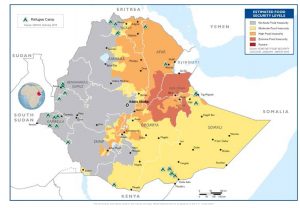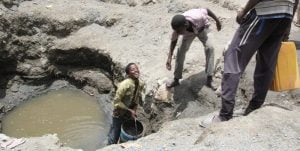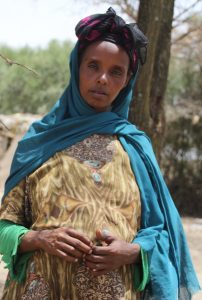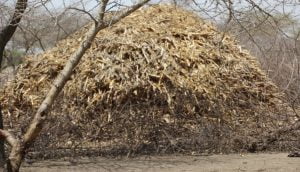Ethiopia Drought: The Worst is yet to come
Kalkidan Yibeltal & Tesfalem Waldyes
The Bulbula River, named after the name of the small town 193km south of Ethiopia within the Rift valley, is no more. The entire water from the river has dried out in the last two months and it now looks a bare river bank. What’s left of it is just a few wells in areas where the river used to flow, which are now the sole providers of water to the residents of the dusty town and their cattle.During the drive to the area, an unusual sand storm frequently covers the villages, making the journey look like it’s a journey through the Sahara desert.
Of the many rivers that flow through this area, administratively called Arsi Negele, in West Arsi zone, are rivers such as Gudo Gedamso, Awede Jitu, Awede, Lephis, and Huluka. Bulbula town residents say Bulbula River was the third or fourth largest. “Our lives depend on this river,” says Alamitu Shabiya, one of the estimated 200, 000 people who depend on the river. A mother of two, Alamitu was a maize farmer who used the river both for her cattle and household consumption.“I have seen this river flow low, but I have never seen it completely disappear”, Alemitu told Addis Standard. “It is like it never existed.” The rain that was forecasted by the Ethiopian Meteorology Agency to last for ten days during the second week of March showed up, but just a day and it was light shower. “Although we have lost the entire maize crop that we have planted in summer of last year, our cattle have survived so far. But if this dryness goes on, they will soon perish,” a worried Alemitu said.
Further down in DakaDallo Harangama village, the issue of water hasn’t affected Madina Qofaa, a mother of four and pregnant with her fifth child. Lake Langano is within a walking distance “of 20 minutes.” “I don’t have cattle to worry about. I had three but my husband had to sell them at a knock down price to buy us food.”
Madina and her husband, Qabatoo, had their entire maize crop collapse as far back in Sept-Oct. 2015. “It just turned brown and collapsed. We didn’t harvest a single maize,”Madina said. Her husband now shuttles between Negele and Shashemene towns working as day laborer. “Sometimes he comes home with 30 to 40 birr, but sometimes he comes empty handed and we all had to go to sleep without eating.” Recently, Madina pulled her 13 year old daughter out of school in Negele town because “she can’t walk for an hour while hungry.”
What makes the case for the families of both Alemitu and Madina different is that they are not suffering from the sever food shortage that already made the lives of 10.2 million Ethiopians (or more) unbearable; their living houses suggest they had a decent life; and their children look they are well looked after. But a maize crop that already failed, a dwindlingfood stock and no rain in the horizon, both familiesare acutely aware thattheir worst days are yet to come.
Barely the scratch
In late March 2016 the United Nations Office for Coordination of Humanitarian Affairs (UNOCHA) in Ethiopia, together with its humanitarian partners, launched a 90-day campaign to raise money to finance Ethiopia’s urgently neededfood aid. The campaign was intended to bridge the US$700 million gap between what is needed and what has so far been secured to aid millions of Ethiopians affected by the ongoing drought, induced by the worst El Nino in recorded history.
“…As we hope for the best, we must also prepare for the worst”
Ever since early 2015, when the effects of the drought first began to be felt in parts of Ethiopia, successive crop failures and widespread livestock deaths have tripled humanitarian needs, according to UNOCHA.Yet out of the US$1.4 billion appeal made by donors and the government only aboutUS$760 million was so far contributed by the government in Ethiopia as well as the international community. It was the reason why Ahunna Eziakonwa-Onuchie, UN Humanitarian Coordinator for the country,kept pressing for “urgent and substantial investment in the humanitarian crisis response this year.”
Her message of urgency reverberates through all humanitarian agencies operating in the country. Jeremy Konyndyk, the director of USAID’s Office of the U.S. Foreign Disaster Assistance team says he is “concerned both at the depth and scale of the need [and] the scale of the challenge.” Speaking to the press on 19th of March, Konyndyk stresses that, “this is the worst drought [the country has had to face] in 50 years” and labeled it a “disaster” if not a catastrophe, yet. “A disaster can be something that happens. It can be an earthquake, a typhoon or in this case [this] drought”.
Dr. Johann Heffnick, Head of the Humanitarian Aid and Civil Protection Department at the European Union Delegation to Ethiopia (ECHO), on his part explains that the drought has resulted in failure of two consecutive harvest seasons: the small Belg (March to May) and the main harvest season of Meher(November-December) 2015; has significantly reduced the general level of water, both for human and livestock; and caused a serious shortage of fodder for livestock. “We are waiting to see if the rain is going to come in this Belg season,” he says in an interview with this magazine. “But for most of the people [affected] we know it’s going to be a problem up until the end of the year.”
Heffnick alarms that the government and its humanitarian partners need to scale up their efforts in order to simultaneously achieve the speeding up of the amount of aid that is coming, as well as make sure that food, water and seeds are distributed to the people in need sooner rather than later. Thenecessary response is already underway, he argues,but admits the scale of the intensifying emergency needs surpasses the resources at hand.
Running against time
Owing to the severe shortage of rain throughout 2015, the loss of agricultural production in most of the affected areas was “massive” states Heffnick. “Some of those areas have lost from 50 to 90 per cent of their expected harvest. The lack of water is equally [austere]; wells have dried up, rivers have completely gone arid. This has led to a considerable number of livestock deaths. Hundreds of thousands of livestock have died in some impacted places,” he said.
Bulbula (used to be) River. What’s left of it is just a fews wells
According to a recent USAID assessment report, in the agro-pastoral and pastoral areas of Afar, a highly affected regional state in Easter Ethiopia, the drought has caused the death of approximately 105,000 cattle, more than 440,000 goats and sheep, nearly 15,000 camels, and an estimated 4,500 donkeys. Meanwhile an estimated 1.8 million livestock are facing acute food shortages – affecting at least 118,000 households. The assessment report also underscored that food security and access to safe drinking water across the region continue to deteriorate,generating increased reliance on relief food assistance.
Now, says Heffnick, “we are watching everyday whether or not there will be rain especially in the North Eastern and Eastern parts of the country coming in the Belg season of 2016.” The month of March, however, did not look good. “Some of the areas that need rain badly have so far not gotten any,” says Heffnick. “It might rain later; we hope it does. But it’s not a good beginning [for the season].”
Even though the Meher harvest in the second half of 2015 failed a great deal, whatever came out of it was helpful, Heffnick explains. But the coming four months, from April onwards, are going to see mounting challenges as there aren’t any leftovers from previous harvests. “It would give us a little bit of a breathing space in the middle of the year if something can be produced from the Belg rains in terms of food, but also if it can produce pasture.”
According to UNOCHA, as of the 23rd of March 82,520 households have received seeds for the Belg season, a figure making up just 41.6 per cent of the targeted 198,122 households. The deadline for Belg planting is usually the end of March while the deadline for the season’s requirement funding was December/January.
Nonetheless Konyndyk of USAID is “very confident” that this disaster will not become a catastrophe as “it is entirely possible to ensure that we do not see severe, catastrophic outcomes due to this drought,” yet, “we expect that the period over the summer will be the worst period, so there is a huge amount of preparation that we need to continue to do to be ready for that time.” He bases his faith on enhanced capacity and expertise in terms of humanitarian response observed over the past three decades. “Even though this drought will be more severe, we have far better capability to manage this kind of situation than we had 30 years ago.” However, “our success is not inevitable.”
Recognition, misrecognition
The Humanitarian Requirements Document (HDR) which outlines anticipated humanitarian needs and required funding levels in a given period of time and was last updated in December 2015 reported a projection of 10.2 million people. The figures include 6 million children in need of emergency food assistance for the year 2016. The document gave key priority to 435 000 children under the age of five with Severe Acute Malnutrition (SAM) and 1.7 million children, pregnant and lactating woman with Moderate to Acute Malnutrition (MAM) requiring specialized nutritional support. It also indicated that an estimated 5.8 million people will need water, sanitation and hygiene (WASH) in 2016, as well as 1.3 million children who will need assistance to be able to continue their education.
Nowin the wake of the deteriorating humanitarian conditions the government and humanitarian partners are discussing to revisethe HRD for the second half of 2016. The revisions include increasing the number of people estimated to experience Moderate to Acute Malnutrition (MAM) from 1.7 million to 2.2 million and adjusting the number of children younger than fivewho are expected to face Severe Acute Malnutrition (SAM) from 435,000 to 450,000, according to USAID. In addition, farmers requiring emergency seed support have increased from 2.2 million to 3.3 million. The government is also receiving ad hoc requests for food assistance to support drought-affected people who are not initially included in the HRD.
“I have seen this river flow low, but I have never seen it completely disappear” Alamitu Shabiyya
As part of the response to tackle the risk of communicable diseases in drought affected areas due to delayed and incomplete food assistance distributions, as well as limited access to water, sanitation, and hygiene (WASH) services, the government and its humanitarian partners have made plans to vaccinate 25 million children against measles in more than 500 drought-affected Woredas (districts), according to USAID.
However a source from a humanitarian agency points out that there has always been “different levels of recognition of [the magnitude of] crisis” between the government and the humanitarian agencies. This time, according to the source who wants to remain anonymous, the humanitarian agencies are pushing for the number of people in need as high as “20 million, together with the chronically vulnerable people under the government’s safety net program.” A discrepancy between the government and the aid agencies on the severity of the situation is also seen while the latest HRD is being debated. “Even within the government, the experts and the technicians fully comprehend the gravity of the problem,” asserts our source. “But these debates are as much with politicians as they are with experts.”
For Heffnick of ECHO, though, the response to the drought from the government has so far been nothing but commendable. “We cannot say the response was bad or slow compared to the historic responses of the 1984/5, 1997/8 and 2003,” he says pointing to the fact that there has already been a US$280 million contribution from the government. “It has also issued a tender to buy one million tons of wheat. That’s unprecedented. But the challenges are enormous.”
That said, in the initial period of the alarm, it took the government some time to fully acknowledge the severity of the problem,creatingunnecessary delays to ring the alarm bells;the government initially claimed the country was readyto handle it on its own.But appeals soon followed as the number of the people in need skyrocketed. Nonetheless the authorities still resort to downplaying the severity of the crisis.
In January 2016, Mitiku Kassa, Head of the National Disaster Risk Management Commission confidently declared that there was enough supply of food for the people in need of food aid.Speaking to the state owned Ethiopian News Agency on March 27th, Mitiku repeated his statement and declared that there was enough stock of food and non-food items, and the government was distributingboth properly for all the people living in “parts of the country affected by the drought”. “There isno food shortage”, he said.
The worst is yet to come
Of the 790 urban and rural Woredas in the country 429 are affected by the drought, a number the government often refers to as “some.” According to Heffnick 186 of these Woredas are currently hotspot ‘Priority One’ districts, means they are areas that need urgent humanitarian assistance. Other 106 Woredas are in ‘Priority two’. Hotspot classifications consider the impact of food availability, WASH infrastructure, access to markets, the nutrition situation, and other contributing factors. Heffnick fears that “a break in the food pipeline might happen.” The country may have enough food at hand to distribute, but the road ahead is tough. “Things are going to get worse before they get better,” he admits. “And if the global community doesn’t respond [as quickly as possible], the next couple of months could be bleak in terms of aid supply.” Further complicating the problem is the fact that “even if we get the money today, it doesn’t mean the food will be in the hands of the needy tomorrow.”
In addition to significant funding gaps the challenge is further intensified by inadequate logistical capacity to efficiently manage the ever increasing relief commodity fleets and delivery. The system of relief aid distribution the country employs so far has been supporting an average of 3 to 4 million beneficiaries every year. It is now expected to meet the needs of triple that number, or most likely, more.
Several weather forecasts predict the current El Nino to recede slowly from July this year onwards, or so hopes Heffnick. If the Belg rains (March to May) do not arrive fast and sufficiently, the near future is going to be “glimmer than one would hope.” But if there is going to be yet another dry spell during the main rainy season of June to August, the problem would even be more severe. Konyndyk agrees. “The current projections are that the summer rains should be pretty good. If they’re not, that obviously will increase needs. If the Belg rains fail, that will increase needs.”
“We are cautiously optimistic about that not happening” Heffnicksays, “but as we hope for the best, we must also prepare for the worst.” For a country experiencing a drought the kind of which has not been seen in over 50 years, several things are hanging on so many ifs and maybes.
Bulbula River “is like it never existed”
Logistic nightmare
What is often neglected while discussing the current drought is the issue of logistics to reach out to those in dire need of food aid.In October 2015 the government in Ethiopia bought one million tons of wheat; another tender for the purchase of 500,000 tons was issued in March of this year.Imports are expected to increase to 2.5 million tons by September, according to the US Department of Agriculture. This surge in purchase is likely to further escalate the congestion at the Port of Djibouti, the entry point where more than 90 per cent of the nation’s imports come through.
Heffnick estimates that on average more than a month is necessary to unload aid carrying ships at the port. But a report from Save the Children released in February of this year estimates that the purchasing and transportation of food into the country through Port of Djibouti could take up to four months.
“We are also prioritizing logistics because it’s very difficult to take an architecture that is built to feed eight million people [who are alreadyin the Safety Net program] and add 10 million people on top of that,” Konyndyk of USAID said, adding “We’re looking at the viability of some different options because it would be helpful to take some of that congestion off of the Port of Djibouti.”
The congestion at Port of Djibouti necessitated a visit by high level government officialsin early March, including officials from the Ministry of Transport,and the Ethiopian Shipping and Logistics Services Enterprises.
On March 27 Capital, a private English weekly, claimed it has learned that at the onset of the year, aware of what was to come, Port officials from Djibouti informed Ethiopian authorities of the necessity to anticipate and prepare sufficient truck fleet to uplift all expected bulk vessels.
Workneh Gebeyehu, Minister of the Ministry of Transport, said that currently up to 780 trucks per day were carrying cargo from the port and the government has planned to increase the number of trucks to 1140 per day. The problem, according to Workneh, is the country lacks sufficient amount of trucks. “We have [a total of] 9,000 trucks assigned to the port cargo, but we need up to 13,000 trucks to accelerate the fleet.”
Madina and her husband had their entire maize crop collapsed as far back in Sept-Oct. 2015
On March 24, citing information on the port’s website and its ship-tracking data, Bloomberg reported that “At least 10 vessels” were waiting to unload “about 450,000 metric tons of wheat… one carrying 50,000 tons of wheat and sorghum is berthed.”
The overload at the Port of Djibouti “heightened by a quadrupling of the food aid than last year,” is only the first problem when it comes to logistics according to Heffnick. The transportation of the food and nutritional products to various hubs inside the country is another mammoth challenge by itself. “And then you have to transport the aid from these hubs to the Woredas and Kebeles (smaller districts) in need,” he explains. “In order for this [to happen smoothly] we need not only a lot of trucks but also efficient organization.” As water shortages are rampant in drought affected areas, water trucking system should also be enhanced, Heffnick contends.
Using “all means at our disposal” is essential and to that end engaging the private sector is one option, according to Heffnick. “We are seeing examples of that in water trucking,” he says referring to UNICEF’srecent successful contract with a private transport company to deploy additional 100 trucks to help reduce the water supply gap.This helpedaid agencies to reach some 350,000 people. But considering the fact that the people receive only 5 liters of water per person per day, “we cannot even remotely say this is enough.”
Another direction the government could possibly take in order to narrow the trucking gap, both for food, nutrients as well as water, is to engage the army, Heffnick suggests. “That could help alleviate the problem.”
In addition to being hit by one of the worst droughts in over 50 years, the country has experienced civil unrests in several parts particularly in Oromiya regional state, the largest of the nine states, during the past six months. As the drought and the unrest collide in some parts like the West Arsi and East Hararghe Zones, the distribution of aid has been obstructed, acknowledges Heffnick, creating another logistic hiccup for aid agencies.
Slipping downwards
Jeremy Konyndyk of the USAID emphasizes the importance of building “a series firewalls”, protections that can be placed to prevent people from slipping into the next level of vulnerability. “By the time someone becomes severely malnourished, a lot of those protections have failed,” he says. Protecting people from reaching that point of vulnerability should be a priority.
However as Ethiopia’s rain dependent, largely backward, agriculture is seriously challenged by successive rain shortages the number of people slipping downwards is certain to surge.
Back in Daka Dallo Harangama village, Madina waits for her husband Qabatoo to come with some money and “some bread for the children.” A farmer only a year ago, his life and the lives of his family now depends on what he earns as a city laborer. “Sometimes, he fails to come home because he has had bad luck getting money and doesn’t want to come to home empty handed,” said his expectant wife. “With every passing day, I am seeing my family slipping into absolute destitution.”
Photos: Addis Standard




 Dr. Johann Heffnick
Dr. Johann Heffnick




